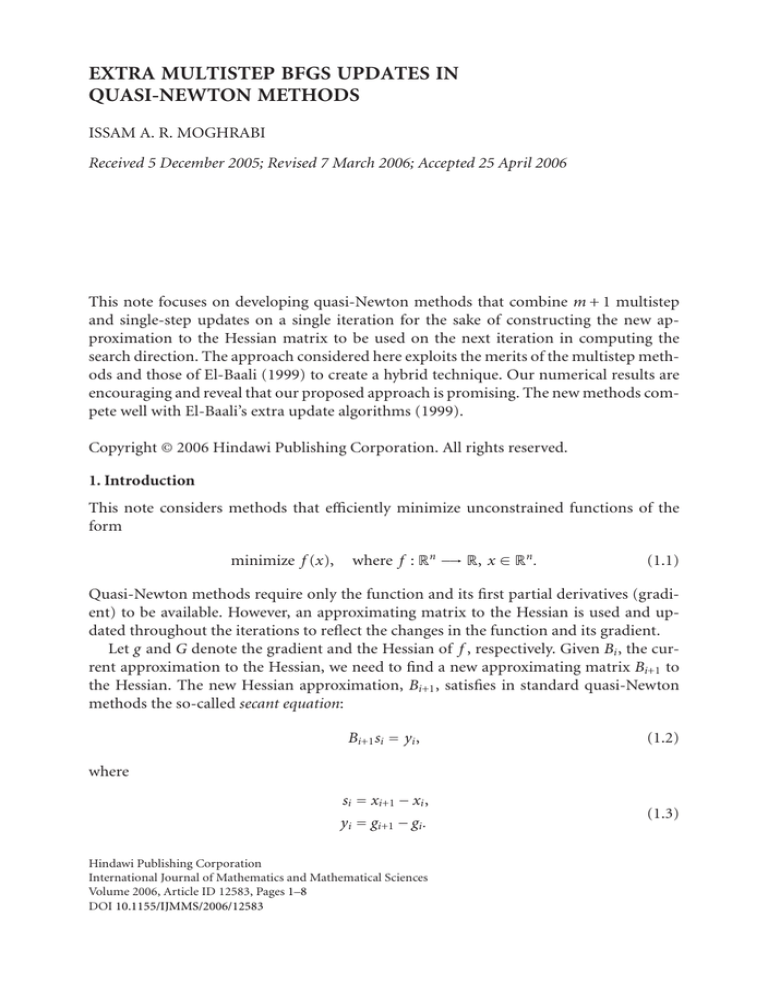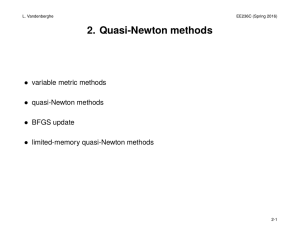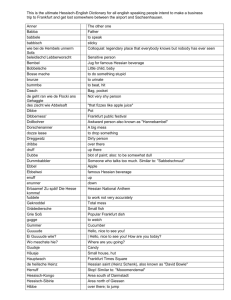
EXTRA MULTISTEP BFGS UPDATES IN
QUASI-NEWTON METHODS
ISSAM A. R. MOGHRABI
Received 5 December 2005; Revised 7 March 2006; Accepted 25 April 2006
This note focuses on developing quasi-Newton methods that combine m + 1 multistep
and single-step updates on a single iteration for the sake of constructing the new approximation to the Hessian matrix to be used on the next iteration in computing the
search direction. The approach considered here exploits the merits of the multistep methods and those of El-Baali (1999) to create a hybrid technique. Our numerical results are
encouraging and reveal that our proposed approach is promising. The new methods compete well with El-Baali’s extra update algorithms (1999).
Copyright © 2006 Hindawi Publishing Corporation. All rights reserved.
1. Introduction
This note considers methods that efficiently minimize unconstrained functions of the
form
minimize f (x),
where f : Rn −→ R, x ∈ Rn .
(1.1)
Quasi-Newton methods require only the function and its first partial derivatives (gradient) to be available. However, an approximating matrix to the Hessian is used and updated throughout the iterations to reflect the changes in the function and its gradient.
Let g and G denote the gradient and the Hessian of f , respectively. Given Bi , the current approximation to the Hessian, we need to find a new approximating matrix Bi+1 to
the Hessian. The new Hessian approximation, Bi+1 , satisfies in standard quasi-Newton
methods the so-called secant equation:
Bi+1 si = yi ,
(1.2)
where
si = xi+1 − xi ,
yi = gi+1 − gi .
Hindawi Publishing Corporation
International Journal of Mathematics and Mathematical Sciences
Volume 2006, Article ID 12583, Pages 1–8
DOI 10.1155/IJMMS/2006/12583
(1.3)
2
Extra multistep BFGS updates in quasi-Newton methods
In general, updating formulas are of the form Bi+1 = Bi + Ci , where Ci is a correction
matrix.
The most successful rank-two formula, developed independently by Broyden, Fletcher,
Goldfarb, and Shanno, is known as the BFGS formula. This formula is given by
BFGS
= Bi +
Bi+1
yi yiT Bi si sTi Bi
− T
.
yiT si
si Bi si
(1.4)
Numerical results indicate that the BFGS method is superior to other updating formulas, especially when inaccurate line searches are used [8, 10, 11].
The note starts with a brief account of some of the successful multistep algorithms that
will be used in the numerical comparisons in the last section of this note. Then the new
implicit updated algorithms are derived. We finally present the numerical comparisons.
2. Multistep quasi-Newton methods
Let {x(τ)} or X denote a differentiable path in Rn , where τ ∈ R, or simply the path X.
Then we apply the chain rule to the gradient vector g(x(τ)) in order to find the derivative
of the gradient g with respect to τ to obtain
dx
dg
= G x(τ)
.
dτ
dτ
(2.1)
Therefore, at any point on the path X the Hessian G must satisfy (2.1) for any value of
τ, specifically for τ = τc , where τc is a constant scalar and τc ∈ R. This will result in the
following equation, called the “Newton equation” [4, 8]:
dx dg = G x(τ)
.
dτ τ =τc
dτ τ =τc
(2.2)
Since we wish to derive a relation satisfied by the Hessian at xi+1 , we choose a value for
τ, τm , that corresponds to the most recent iterate in the Newton equation as follows:
g τm = Bi+1 x τm
(2.3)
or equivalently,
wi = Bi+1 ri ,
(2.4)
where vectors ri and wi are given, with respect to the m most recent step vectors {sk}ik=i−m+1
and the m most recent gradient difference vectors { yk }ik=i−m+1 , respectively, in the following forms:
⎫
⎧
m
⎬
⎨ ri =
si− j ⎩
Lk τm ⎭ ,
j =0
k=m− j
⎫
⎧
m
−
1
m
⎬
⎨
y i− j ⎩
Lk τm ⎭ ,
wi =
m
−1
j =0
k=m− j
(2.5)
Issam A. R. Moghrabi 3
def
def
where si = xi+1 − xi , and yi = gi+1 − gi ,
Lk τm = τk − τm
Lm τm =
−1 τm − τ j
τk − τ j
m
−1
τm − τ j
k < m,
,
−1
(2.6)
,
j =0
and {Lk }m
k=0 are the standard Lagrange polynomials.
The choice of the parameters, τk , for k = 0,1,2,...,m, are chosen such that they depend
on some metric of the following general form:
φM z1 ,z2 =
z1 − z2
T
M z1 − z2
1/2
,
(2.7)
where M is a symmetric positive-definite matrix.
This metric is used to define the values {τk }m
k=0 used in computing the vectors ri and
wi . The choices based on this metric are numerically better than the unit-spaced method
since they take into account the spacing between the iterates using some norm of measure
(see [5]).
Several choices were considered for the metric matrix M. For instance, if M = I, we
obtain the following (for m = 2):
(a) accumulative algorithm A1: τ2 = si 2 , τ1 = 0, τ0 = −si−1 2 ;
(b) fixed-point algorithm F1: τ2 = 0, τ1 = −si , τ0 = −si + si−1 2 .
The new B-version BFGS formula is given by
Multistep
Bi+1
= Bi +
wi wiT Bi ri riT Bi
− T
.
wiT ri
ri Bi ri
(2.8)
3. Extra BFGS updates
The BFGS formula corrects the eigenvalues of the Hessian approximation, Bi , although
this correction is found inadequate in practice when the eigenvalues are large (see Liu
and Nocedal [9]). It is, therefore, as El-Baali [3] states, desirable to further correct those
values. It should, however, be stated that such values are not readily available and they
can only be estimated rather than do any expensive computations for exactly obtaining
them. A well-known formula can be employed to detect the presence of large eigenvalues
as will be specified in the next section. It is thus envisaged that extra updates applied to
Bi will introduce the desired corrections to the large eigenvalues.
We now present the ingredients of the extra update methods. Byrd et al. [2] propose
for some m ≤ n (n is the problem dimension) the following extra update:
Gi+1 u(t) = v(t) ,
1 ≤ t ≤ m,
(3.1)
(t) m
where {u(t) }m
t =1 and {v }t =1 are any sequence of independent vectors. The authors were
able to prove, under certain assumptions, global and superlinear convergence on convex
functions. They use some finite differences to approximate the left-hand side of this last
4
Extra multistep BFGS updates in quasi-Newton methods
relation since the Hessian itself is not explicitly available. The convergence results do not
necessarily hold since the above relation is approximated.
One specific choice made by Liu and Nocedal [9] for limited memory BFGS and one
that is also adopted by El-Baali [3] for the vectors u(t) and v(t) is
u(t) = si−m+t ,
u(t) = y i−m+t ,
1 ≤ t ≤ m,
(3.2)
which are retained from the latest m − 1 iterations. El-Baali conjectured that the curvature information obtained from (3.1) may be employed m times (m > 1) to improve the
Hessian approximations.
The methods we develop here (as those of El-Baali [3]) generate, at each iteration,
(t) m
matrices built using only Bi , and the sequences {u(t) }m
t =1 and {v }t =1 are readily available.
We proceed at each iteration i by doing a single standard quasi-Newton single-step update
as follows:
(1)
Bi+1
= BFGS Bi ,si , yi .
(3.3)
The newly obtained Hessian approximation is used in the subsequent m − 1 subiterations
to do multistep updates as follows:
(t+1)
(t)
Bi+1
= BFGS Bi+1 ,u(t) ,v (t) ,
t = 1,2,...,m − 1,
(3.4)
where m is a prescribed constant and
u(t) = ri−m+t ,
v(t) = wi−m+t ,
(3.5)
and the vectors ri and wi are as in (2.5).
The (m + 1)th update is done as
(m+1)
(m)
Bi+1
= BFGS Bi+1 ,si , yi ,
(3.6)
where the matrix obtained from (3.2)–(3.4) updates is the one used in computing the
search direction and hence the new iterate xi+1 . When i ≤ m, then m = i. The secant
equation is satisfied since the last update uses si and yi while trying to exploit the numerical advantages of the multistep methods that use linear combinations of the most
recent step and gradient difference vectors (ri and wi ) in the update process. Thus, in
addition to the secant equation, the following are satisfied:
(t+1) (i−m+t)
Bi+1
r
= w (i−m+t) ,
t = 1,2,...,m − 1.
(3.7)
For m = 1, the proposed approach is equivalent to the standard 1-step BFGS method.
We now state a theorem that addresses the convergence properties of the derived technique.
Theorem 3.1. Let x0 be a starting point for a twice continuously differentiable objective
function f . The sequence {xi } generated by (3.2)–(3.4), assuming B0 is positive definite,
Issam A. R. Moghrabi 5
with a line search for which the following two criteria are satisfied:
fi+1 ≤ fi + σ1 αi sTi gi ,
sTi gi+1
(3.8)
≥ σ2 sTi gi
(3.9)
(for σ1 ∈ (0,1/2) and σ2 ∈ (σ1 ,1)) converges to the minimum x∗ . There is also a constant
λ ∈ [0,1) such that
fi+1 − f ∗ ≤ λk f 1 − f ∗
∀i,
∞
x i − x ∗ < ∞ .
(3.10)
i=1
The proof is similar to that of El-Baali [3] and Byrd and Nocedal [1], and the reader is
referred to those papers for details.
The following theorem shows that the sequence (3.2)–(3.4) possesses the superlinear
convergence property.
Theorem 3.2. Let x0 be a starting point for a twice continuously differentiable objective
function f . Assume that B0 in (3.2)–(3.4) is positive definite and that the actual Hessian G
satisfies a Lipschitz condition
G(x) − G x∗ ≤ γx − x∗ ,
(3.11)
where γ is a positive constant, for all x in the neighborhood of x∗ . Assume also that a line
search satisfying (3.7)-(3.8) is carried out such that if xi − x∗ and Bi si − G(x∗ )si / si are sufficiently small, then the step length αi = 1 is used. The sequence {xi } thus generated
converges superlinearly to x∗ .
Again, the proof is a simple modification of the proof of El-Baali [3, Theorem 2].
It is left to tackle the issue of what m, the number of extra updates, may be chosen to
be. We have tried two options: one is to determine a “good” value for m, based on the
numerical test results. The other option, supported by the results obtained, is to make
the choice on the basis of an estimate of the determinant of the updated Hessian approximation, Bi+1 , as
det Bi+1 =
1
det Bi ,
βi
(3.12)
where
βi =
sTi Bi si
.
sTi yi
(3.13)
As βi decreases, det(Bi+1 ) increases. So, if βi is sufficiently large, the BFGS update introduces slight correction to Bi . An extra update(s) is carried out if βi > 1. Although El-Baali
[3] suggests a relationship between βi and the number of extra updates as follows:
m = min m,βi ,
(3.14)
6
Extra multistep BFGS updates in quasi-Newton methods
Table 4.1. Overall results (876 problems).
Method
M1
Evaluations
86401 (100.00%)
Iterations
73090 (100.00%)
Time (s)
39171.18 (100.00%)
A1
76164 (88.15%)
61335 (83.92%)
31474.71 (80.35%)
EA1
58695 (67.89%)
45492 (62.24%)
13308.42 (77.47%)
Table 4.2. Results for dimensions from 2 to 15 (440 problems).
Method
M1
Evaluations
25589 (100.00%)
Iterations
21648 (100.00%)
Time (s)
319.835 (100.00%)
A1
24494 (95.72%)
19525 (90.19%)
267.253 (83.56%)
EA1
22151 (86.56%)
16990 (76.48%)
266.1 (83.16%)
Table 4.3. Results for dimensions from 16 to 45 (240 problems).
Method
M1
Evaluations
27058 (100.00%)
Iterations
23844 (100.00%)
Time (s)
3429.78 (100.00%)
A1
22995 (84.98%)
19578 (82.11%)
2745.05 (80.04%)
EA1
21111 (78.02%)
17414 (73.03%)
2698.68 (78.68%)
(where m denotes the extra updates at a given iteration), our numerical tests have favored
the choice m = 2 to that made in (3.14). The improvement incurred by our choice and
that in (3.14) has not exceeded 8.4%, based on our experimentation on the new methods.
4. Numerical results and conclusions
Our numerical experiments of the new approach have been done with emphasis on algorithms that satisfy (3.2)–(3.4) by choosing values of {τ j }2j =0 that are consistent with
successful choices published earlier (see [5, 6]). In particular, we have chosen algorithm
A1 (see [5]), corresponding to the most successful accumulative approach as a benchmark, along with the standard single-step BFGS, to compare with the new algorithms for
the same parameter and metric choices made for A1. The new algorithm is referred to as
EA1.
It should be noted here that in our implementation, we are maintaining the matrix Bi
in the factored form (LLT ).
Sixty functions classified into subsets of “low” (2 ≤ n ≤ 15), “medium” (16 ≤ n ≤ 45),
and “high” (46 ≤ n ≤ 80) dimensions (as in [7]) were tested with four different starting points each. Some of the problems tested have variable dimensions and we tested
our algorithms on several dimensions, depending on the specific nature of the problem.
This has resulted in a total of 876 problems. The overall numerical results are given in
Table 4.1. Tables 4.1–4.5 show the total results for each dimension. The tabulated results
indicating the total number of function/gradient evaluations, the total iterations, and the
Issam A. R. Moghrabi 7
Table 4.4. Results for dimensions from 46 to 80 (134 problems).
Method
M1
Evaluations
21146 (100.00%)
Iterations
17431 (100.00%)
Time (s)
13426.87 (100.00%)
A1
18009 (85.17%)
14122 (81.02%)
10835.33 (80.70%)
EA1
15433 (72.98%)
11088 (63.61%)
10344.00 (77.04%)
Table 4.5. Results for dimensions from 81 to 100 (62 problems).
Method
M1
Evaluations
12608 (100.00%)
Iterations
10167 (100.00%)
Time (s)
21994.7 (100.00%)
A1
10666 (84.60%)
8110 (79.77%)
17627.08 (80.14%)
EA1
9411 (74.64%)
7083 (69.66%)
16211.81 (73.71%)
Step 1: Set B0 = I and i = 0; evaluate f (x0 ) and g(x0 );
Repeat
Step 2: Compute the search-direction pi from Bi pi = −gi ;
Step 3: Compute xi+1 by means of a line search from xi along pi , using
safeguarded cubic interpolation (see (3.7)-(3.8));
Step 4: If i = 0, then
{set ri = si and wi = yi }
else
{
calculate the values τ2 = si 2 , τ1 = 0, τ0 = −si−1 2 ;
calculate the vectors ri and wi using (2.5);
if riT wi ≤ 10−4 ri 2 : wi 2 then
{ri and wi are not acceptable for updating Bi ; set ri = si
and wi = yi }
};
Step 5: If i = 0 and n ≥ 10, then scale B0 by the method of Shanno and
Phua [11];
Step 6: Update Bi to produce Bi+1 , using (3.2)–(3.4), with m = 2 (the
number of extra updates); increment i.
Until g(xi )2 < ε (where ε is a problem-dependent tolerance).
Algorithm 4.1
total time provide a good mean to compare the efficiency on each of the subsets as well
as on the complete set of the considered algorithms.
Method M1 corresponds to the standard BFGS. The results presented here show clearly
that the new EA1 method exhibits a superior numerical performance, by comparison
with the other algorithms derived earlier. Method EA1 is outlined in Algorithm 4.1.
8
Extra multistep BFGS updates in quasi-Newton methods
The numerical evidence provided by the tests reported in Tables 4.1–4.5 demonstrates
clearly that the new method EA1 shows significant improvements, when compared with
the standard, single-step, BFGS method and A1. In particular it has yielded, on average,
improvements in the range 26%–30%, on the problems with the highest dimensions. The
results reported in Table 4.2 indicate that, while EA1 does appear to offer some improvement over the method from which it was developed (namely, A1), it is not so superior on
such class of problems. We are currently investigating the issue of whether the numerical
performance of similar methods can be improved further. The convergence properties of
such methods need also be explored.
References
[1] R. H. Byrd and J. Nocedal, A tool for the analysis of quasi-Newton methods with application to
unconstrained minimization, SIAM Journal on Numerical Analysis 26 (1989), no. 3, 727–739.
[2] R. H. Byrd, R. B. Schnabel, and G. A. Shultz, Parallel quasi-Newton methods for unconstrained
optimization, Mathematical Programming 42 (1988), no. 2, 273–306.
[3] M. El-Baali, Extra updates for the BFGS method, Optimization Methods and Software 9 (1999),
no. 2, 1–21.
[4] J. A. Ford and R.-A. Ghandhari, On the use of function-values in unconstrained optimisation,
Journal of Computational and Applied Mathematics 28 (1989), 187–198.
[5] J. A. Ford and I. A. R. Moghrabi, Alternative parameter choices for multi-step quasi-Newton methods, Optimization Methods and Software 2 (1993), 357–370.
, Multi-step quasi-Newton methods for optimization, Journal of Computational and Ap[6]
plied Mathematics 50 (1994), no. 1–3, 305–323.
[7] J. A. Ford and A. F. Saadallah, A rational function model for unconstrained optimization, Numerical Methods (Miskolc, 1986), Colloquia Mathematica Societatis János Bolyai, vol. 50, NorthHolland, Amsterdam, 1988, pp. 539–563.
[8] D. Goldfarb, A family of variable-metric methods derived by variational means, Mathematics of
Computation 24 (1970), 23–26.
[9] D. C. Liu and J. Nocedal, On the limited memory BFGS method for large scale optimization, Mathematical Programming 45 (1989), no. 3, 503–528.
[10] D. F. Shanno, Conditioning of quasi-Newton methods for function minimization, Mathematics of
Computation 24 (1970), 647–656.
[11] D. F. Shanno and K. H. Phua, Matrix conditioning and nonlinear optimization, Mathematical
Programming 14 (1978), no. 2, 149–160.
Issam A. R. Moghrabi: Department of Computer Science, Faculty of Science, Beirut Arab University,
Beirut 115020, Lebanon
E-mail address: imoghrabi@bau.edu.lb







